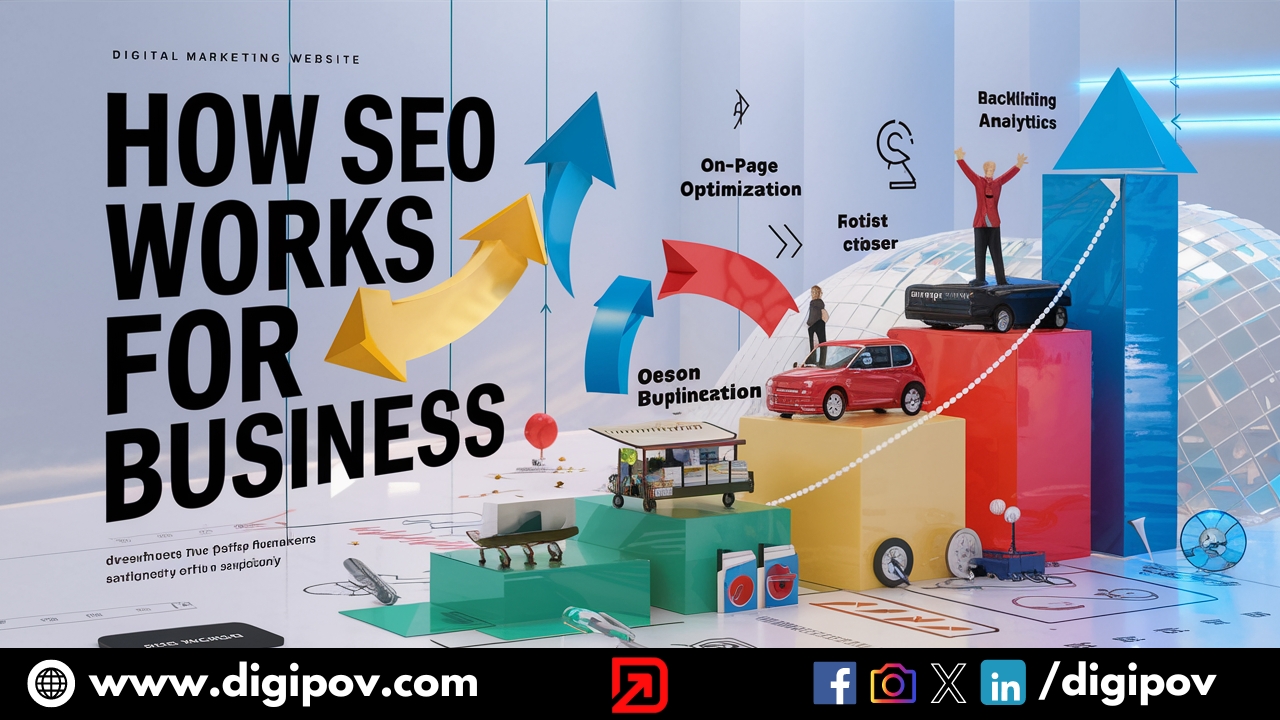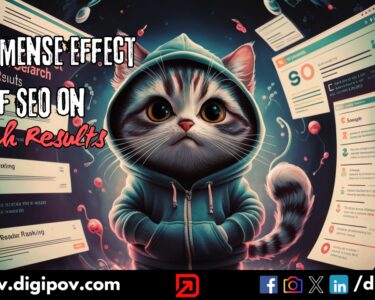Search Engine Optimisation (SEO) is one of the significant parts of digital marketing for your business. It improves your visibility over the web among your target audience, helps in building credibility, creates increased organic traffic, allows targeted marketing and provides a competitive advantage. This is not all as SEO helps your business in creating long-term growth and success by supporting the arrangement of enhanced user experience.
Before delving deep into the SEO activities and strategies for business, Let’s understand its concept.
What is SEO?
SEO is Search Engine Optimisation which involves activities or actions to maximise the potential of the business page. It is to rank higher on Google and other search engines to attract more audience and increase the exposure of your business.
Basics of SEO
In psychology, Maslow’s Hierarchy of Needs is the theory which explains the basic or fundamental needs required by humans to lead an effective life. A similar theoretical model is created by Rand Fishkin of Moz known as Mozlow’s Hierarchy of SEO Needs. The model informs the successful steps to be followed to achieve a good foundation of SEO. The steps are as follows:
- Allowing crawling accessibility to engines on your business page to help them read updates and features on the website
- Creating compelling content to answer every search query of the audience
- Keyword-optimised web pages for attracting potential search and visibility on search engines
- Ensuring faster upload of pages and creating compelling UX design to increase page attractiveness in promoting greater user experience
- Developing share-worthy content which earns citations, links and amplifications
- Creating SEO page titles, URLs and descriptions to attract high click-through-rate (CTR)
- Snippet mark-up for standing out on SERP
How does SEO work?
The three primary functions which direct search engine optimisation are crawl, index and rank.
- In SEO, crawling is allowing search engine bots to systematically discover the uniqueness of the content on your website. It analyses texts, videos, images, clipart and any other nature of files presented on your page.
- Indexing is the process of organising information gathered during crawling on the page. A well-indexed content from page would ensure likely appearance on higher rank on SERP. It also improves the chance of drawing increased organic traffic.
- Ranking is providing positioning of the content pieces in answering a search query in the form of most to least relevant. The aim of your business to reach a higher rank on SERP to ensure increased visibility.
Many express doubts regarding different aspects of SEO to be focused on which would work for their business. Well! It’s natural because there are wider factors influencing different aspects of SEO.
So, here is a detailed guide to critical aspects of SEO that works for your business.
Types of SEO and Ways to Use Them for Business
In managing your business, each of the types of SEO is to be implemented as they have varied aspects to enhance the visibility and increased reach of your business page to the target audience.
- On-Page SEO: On-page SEO involves all types of optimisation activities executed on managing the website page and content for the business. It assists pages to rank higher on Google and attracts more target audiences to engage with the webpage. A few of the factors for On-page SEO which would help your business rank higher are:
- Title page: The title tag introduces the users to the topic on the page. It is present in the bowser title bar and SERP. It is important to be added and optimised as they play a major role in supporting organic ranking. Title tags are to be written within 70 characters or less involving focus keywords and content ideas of business.
- Meta Description: The meta description is the HTML element which provides a short summary of the content on the webpage. It is displayed as a search snippet to help the users have an idea of the nature of the content and facts that exist on the page. The best way to form meta description is to keep it within 155-160 characters with use of active voice. The use of a focus keyword is a must and a call-to-action is essential to be added. Moreover, focus on making the summary unique and ensure it matches the written content with mention of specifications from the content whenever required.
- Internal Links: The interlinking is making hyperlinks to the content present on the website which can enhance ranking on the search page. It helps readers or users to gather further information in developing a better understanding and answers for their queries.
- Alt Tag and Image: In the webpage, when adding any image on your blog post ensure to include a target keyword in the alt tag as well as the image name. It is part of boosting the SEO rankings and create better-indexed images on the page to allow effective reach.
A thing to keep in mind while using keywords is avoiding to over stuffing them in the content. This is because it will result to get you penalised and your content removed from the search. Moreover, execute proper interlinking, develop a sitemap and submit it through Google Search Console. The content on the webpage is required to be mobile friendly as most of the users nowadays use mobile compared to laptops to view content to get answers to their queries.
Some of the key off-page SEO factors to be kept in mind are site architecture, user-friendly URLs, keyword optimisation, well-developed content, page loading speed, quality of outbound links, use of HHTPS, image optimisation, readability of content, UX design and click-through-rate (CTR). - Off-Page SEO: Off-page optimisation is SEO practice that occurs outside the webpage of your business in promoting your content and improving pageview ranking in SERP. A few major off-page SEO activities are:
- Backlinking/ Link Building: Backlinking is the process of generating natural links for the page from reputable websites. It helps in improving the page rank along with drives increased traffic. This is because it helps the audience from the reputable site to be diverted towards your business page. Moreover, increased backlinking by potential sites ensures the authenticity of the webpage which makes it to rank higher.
- Local Citations: It involves mentioning the name, address and phone number of the business on a different site beyond your own to create business promotion. It enhances ranking of your page in local search results.
- Guest Posting: It is the practice to create and publish content on a different website other than your official site as an author. Its key purpose is to develop backlinks to ensure improved ranking.
- Content Marketing: It is one of the key aspects of off-page SEO which helps in earning backlinks, gaining media attention and regularly adding new content on the webpage. The quality and nature of the content marketed decide the amount of traffic to be diverted towards the business site. The presence of improved content is indexed effectively with higher SERPs and allows increased business exposure.
A few of the common content types used for off-page SEO are blog posts, whitepapers, social content, infographics, video and audio recordings and others. The blog posts are usually created to share detailed business purposes and activities on various social media platforms such as LinkedIn, Facebook, X and others. The whitepapers are in-depth analytical reports regarding a specific subject of your business. It mainly highlights the features and uniqueness of the products or services to encourage the reader to be involved in business with you. The use of graphics, statistical information and content required to be unique to ensure quick engagement.
The infographics are to be engaging for the audience and search engines. In creating effective infographics understand the essential points needed to be added to them as required by the audience. You are to determine the way to maintain brief information, appropriate organisation and design preferences in developing appropriate infographics. The success of content marketing in off-page SEO is to be measured by evaluating lead generation, website traffic, sales, web traffic, onsite engagement, social engagement and SEO success. - Google Business Profile: The Google Business account optimises the online presence of the business beyond the website. It helps to promote the business at local and national levels as required to attract the target audience.
- Technical SEO: Technical SEO involves the actions that enhance the technical aspects of the website to improve its ranking on the SERP. It involves taking actions to make the website load faster, easily crawled and understandable by the search engine. It is required for SEO purposes in business as it helps in increasing organic traffic. Technical SEO involves use of meta robots tag and robots.txt file for crawling the site to share key information in ranking the page. A good technically optimised content would have no deadlinks and duplicated information, ensure security, present structured data and has an XML sitemap.
Organic Search vs. Paid Search
In promoting your business, organic search as part of SEO and paid search are used.
Concept: Organic search indicates the involvement of varied SEO practices in optimising a website to draw traffic from unpaid search results in promoting your business. In contrast, paid search (known as pay-per-click) is digital marketing strategy used to pay a fee for getting the ad clicked each time. It is used for promoting buying of products and services from the website.
Position on the page: Paid searches always appear at the top of the SERP page followed by organic search information which is below them.
Time: Paid searches helps in getting immediate attraction of traffic to your site. However, organic search takes time in driving traffic to your site as it the optimised content takes time to rank of the SERP.
Return on Investment (ROI): Paid search helps in easier return on ROI compared to organic search. Further, the ROI is easier to be calculated in paid search compared to organic search. However, 53.3% of traffic is drawn through organic search compared to 27% through paid search. Further, B2B business generates twice the revenue through organic search or SEO approach compared to other channels. This indicates organic search to be more valuable in receiving ROI compared to paid search.
White Hat SEO vs. Black Hat SEO
In your business, you need awareness about white hat and black hat SEO to understand the crucial aspects of SEO that can help you gain traffic and may be responsible in losing page authenticity.
| White Hat SEO | Black Hat SEO |
| · Presentation of relevant content related to the mentioned topic· Well-exposed images and detailed description· Relevant linking· Good content with no errors· Unique and relevant page title | · Inappropriate content which does not link with study topic· Keyword stuffing· Addition of invisible texts· Irrelevant linking· Poor quality content with increased error· Inappropriate title tag |
Importance of SEO for Small Business
In small businesses, SEO plays a major part towards its promotion and growth in the digital field.
- Enhances Visibility: The right SEO practices for your business would help in increasing your visibility on the SERPs. It would help your small business to be in a better competitive space compared to others.
- Increases Brand Awareness: SEO helps small businesses to extend their branch reach to target audience and assist them to easily recognise their business. It is critical for the business growth and allows the brand to involve in business with likely people. It boosts brand awareness by ranking the content on your site at a higher place on SERPs
- Promotes Higher Sales: SEO creates a snowball effect which leads to create high-quality leads in turn boosting sales for your business. This is because effective optimisation leads your business to be highly discoverable by target audience and ranks higher which makes people interest in buying from you.
- Assist to Build Credibility: The higher rank of your business on the SERPs indicates increased credibility and trust by the search engine to promote your business. It helps you to attain authority in the industry as more people finds your content to be relevant and intend to buy from you.
SEO Strategy for Small Business
There are loads of SEO strategies present to be used for promoting your small business which cannot be covered within such a short time. However, I will highlight few of the key strategies to be followed as strategies to promote your small business.
- Develop a well-specified Google Analytics and Google Search Console account to gain insight into the traffic and metrics guiding your business.
- Set up a well-optimised Google Business Profile to create enhanced online presence
- Create unique content by executing effective keyword research
- Identify and analyse SERP competitors
- Use on-page and off-page SEO optimisation elements
- Create potential backlinks for your business
- Monitor your performance and local listing
- Track your ranking
Frequently Asked Questions (FAQs)
1. What is the use of SEO in business?
In any business over digital medium, the SEO helps to increase its visibility, attract target audiences, increases credibility and trust.
2. What SEO metrics are to be considered for business?
The key SEO metrics to be selected are keywords, SERP results, engagement rate, click-through rate, brand awareness, domain authority and lead generation.
3. What SEO practices are essential for a higher ranking of business on the SERP?
The mention of primary keywords on the title tag, increased loading speed of website, quality backlinks, better website reputation and mobile friendliness.
Conclusion
A correct SEO approach would create better business positioning over the search engine ranking page (SERP) and increase your business exposure to the target audience. So, never think of compromising your SEO activities out of any trouble throughout the business.



